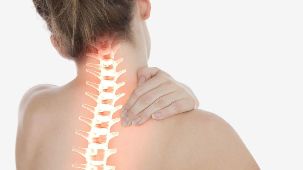
Cervical osteochondrosis - a disease of the cervical spine, with degenerative and dystrophic processes in intervertebral discs.
More than 80 % of the population complains of pain in the neck. In addition, 30% of headaches are directly linked to cervical osteochondrosis.
If before this disease experienced the elderly, but more and more are suffering from degenerative disc disease of the neck of the 20-30-year-old patient.
Reasons
The most unfavorable causes degeneration of the vertebrae of the neck are:
- lack of exercise, simply put, lack of exercise;
- irrational nutrition;
- long-term physical exertion;
- salt deposits;
- a variety of injuries;
- violation of metabolism and excess weight;
- prolonged sedentary work (eg. computer) without interruption;
- wrong organized a place to sleep (mattress, pillows);
- long distance or continuous driving.
Also risk factors are: hypothermia in the cervical, heredity, hormonal disorders.
In addition, to promote the treatment of cervical degenerative disc disease can autoimmune diseases such as rheumatism, systemic lupus erythematosus.
The disease develops slowly, but is prone to the progression.
Symptoms
Key symptoms of degenerative disc disease in the neck:
- pain. It can be both small and serious pain in the neck;
- numbness. Usually this is in the region of the arm, shoulder, scapula, neck, can also be a feeling, tingling. The most typical is the crunch in the neck when turning the head;
- noise and ringing in the ears. Sometimes hearing loss;
- migraine and headache, muscle weakness in the arms and legs;
- nausea, shortness of breath. It seems that he can't breathe, it leads to oxygen starvation;
- blurred vision. The observed blurring of vision, reduced visual acuity, there is a so-called "flies" before eyes;
- instability of blood pressure. The patient plagued by high or low pressure, the result is dizziness.
Like pain, so in most cases it tends to a patient, when you turn your head or after sleep, low physical activity at hand, cough or sneeze. The pain can be, so to speak, to "give" in the occipital region, shoulders and arm. If you tilt your head forward, often the pain under the shoulder blade.
Diagnosis
Make a diagnosis of cervical degenerative disc disease, you should consult an orthopedic surgeon or a neurologist. He makes the inspection and examination of the patient, sent to x-ray, cervical from several different angles. In some cases, may require MRI scanning and MRI diagnosis.
Treatment
Cervical osteochondrosis needs a long, systematic and stepwise treatment. Mostly the goal of treatment is to eliminate pain, and fight inflammation.
The initial stage of the disease is enough of manual therapy, therapeutic exercises. More running - you need medication.
It is also important to create conditions for the regeneration of damaged tissues, you can do this, use products which have vitamin B in the form of injections or tablets.
It is necessary to observe the regime of work and rest, take care of comfortable sleep, not to lift weights and to stop the addiction.
Complications
Osteochondrosis of the cervical many consider a rather insidious disease. After all, since the cervical vertebrae are located close to each other, so the slightest deformation of the compressed nerve roots and blood vessels. In the end, disturbed cerebral blood circulation, which leads to headaches, migraines. In advanced cases, it is fraught with ischemia or spinal cord, and even stroke.
The risk is, and the cardiovascular system. Some people observed cardiologist, because of the pain in the heart, constantly "churning" of high pressure, and the reason is osteochondrosis of the neck.
Also, due to the compression of nerve endings, the patient may suffer from hearing, vision, disturbed coordination of movements.
In advanced forms and without proper treatment, the formation of hernias, treatment, who need surgical treatment.
In the elderly the cervical osteochondrosis is often combined with deforming arthrosis of the cervical spine, vertebral wear, etc.
Prevention
To avoid cervical degenerative disc disease, you need to live a healthy lifestyle, eat a healthy diet, do regular exercise. A big role in the proper organization of the workplace and compliance with the regime of work and rest periods.
































